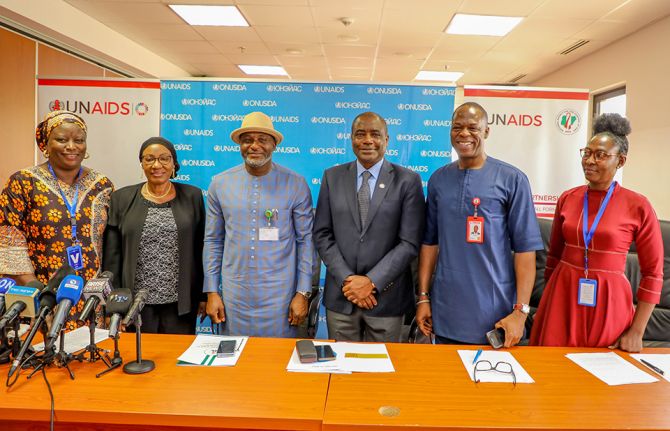
Feature Story
A mother’s joy, a mother’s challenge: Cameroon copes with mother to child HIV transmission
21 May 2010
21 May 2010 21 May 2010
UNAIDS Executive Director Michel Sidibé visited the outpatient clinic and maternity ward at Yaoundé’s central hospital. 19 May 2010.
After almost ten years, 28-year old Angele is a mother again. “My daughter is my joy. She is such a wonder,” said the young woman who wishes to keep her identity a secret as she is living with HIV in Oug-ebe, a shantytown in Yaoundé, Cameroon.
She found out she was HIV-positive in 2001 when she underwent a test at the time of her first pregnancy. Even though she took antiretroviral treatment to prevent HIV transmission to her fetus, her baby was born HIV-positive and died after nine months from an AIDS-related illness. “They told me that I was in a highly infectious stage when I was pregnant so the drugs didn’t work. I was devastated. Only after almost ten years, when I heard the science had improved did I get pregnant again," said Angele.
And her gamble paid off with a gift: Crissile (not real name) a healthy baby girl who is HIV free. While Angele savours each moment with the playful toddler, she confesses that she still lives with a shadow of doubt. “I always worry that maybe the diagnosis was wrong. They say the test isn’t always right”.
An addition to that gnawing concern is her daily struggle with stigma and discrimination. During the interview, she nervously closes the window and shuts her door, to keep her disclosures from curious neighbours. “We rent this place and if the neighbours found out I was HIV-positive, I might get kicked out of my home,” said Angele.
At the moment she is a volunteer in an outpatient clinic in Yaoundé’s central Hospital, but has no job and relies on her family for support.
Over the past ten years the clinic, which provides care management and treatment for HIV patients, has seen a lot of progress. Last year, it treated more than 26-thousand HIV patients and put more than 6000 on antiretroviral therapy. “I think discrimination has gotten better, but we still mask what we do by also saying we treat skin diseases, so our HIV patients have a cover,” said the centre’s director, Dr Charles Kouanfack.
Cameroon has led the way in Africa in decentralizing its AIDS response. Now almost all health districts are equipped to prevent mother-to-child HIV transmission (PMTCT). While coverage of treatment to prevent babies from getting HIV reached almost 34% of pregnant women living with HIV in 2009, a vast improvement from the 18 % of 2008, the country still has a long way to go. Dr Kouanfack says while health districts have reached almost their maximum level of PMTCT coverage the problem is that many women do not go to hospitals and clinics to give birth. Pregnant women in rural and marginalized communities will have their children at home with a mid-wife. So, the next step would be to implement strategies to reach out to vulnerable women.
However, ramping up HIV coverage has had other benefits. “The resources which have gone to HIV treatment have also helped improve the capacity of health systems in general. We see that ameliorating the management of HIV has helped increase the professionalism of our laboratories and medical staff,” said Dr K Kouanfack.
UNAIDS Executive Director Michel Sidibé has championed the prevention of mother to child HIV transmission. He has made the eradication of babies born with HIV a top priority. “It is not acceptable that in countries like France or the US practically no pregnant HIV positive women give birth to babies with HIV, but in places like Cameroon, still far too many babies are born with HIV,” said Mr Sidibé. “This kind of inequality is intolerable. We know we can stop mother to child transmission of HIV, so we must continue to redouble our efforts to overcome this injustice.”
He visited the HIV treatment centre and maternity ward at Yaoundé’s central hospital this week and praised the efforts Cameroon has made to eradicate the transmission of HIV from mother to child. But he called on the leadership to continue to expand prevention measures and become a model of PMTCT in Africa.
A mother’s joy, a mother’s challenge: Cameroon co
Multimedia:
Feature stories:
African nations celebrate 50th anniversary (20 May 2010)
International conference begins in Cameroon (17 May 2010)
UNDP to partner with Sony and JICA in Cameroon and Ghana during FIFA World Cup (30 March 2010)
New wave of cooperatives in Cameroon help HIV-positive women gain economic independence (25 February 2010)
UNAIDS, Universal Postal Union, UNI Global Union and ILO launch global HIV prevention campaign (07 July 2009)
Publications:
Joint Action for Results: UNAIDS Outcome Framework (2009–2011) (pdf, 932 Kb.)


